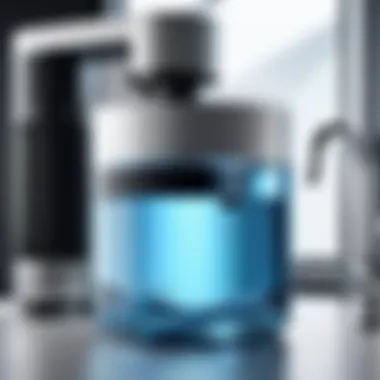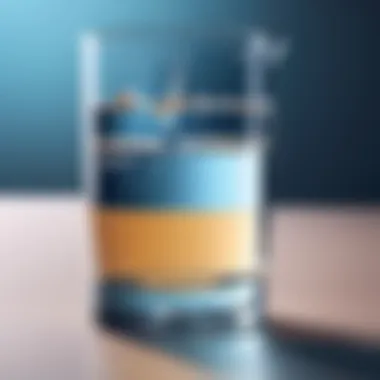How to Make Drinking Water: A Detailed Guide to Purification


Intro
Access to clean drinking water is a fundamental necessity for health and well-being. Unfortunately, various global factors contribute to the contamination of our water sources. This guide aims to address the multifaceted challenges associated with purifying drinking water. By exploring established techniques and innovative solutions, readers will gain insights into best practices for attaining and maintaining safe drinking water.
Technology Insights
Latest Tech Trends
Advancements in technology significantly influence water purification methods. Modern filtration systems now use various methods, such as reverse osmosis, UV purification, and nanotechnology. These innovations ensure greater effectiveness in removing contaminants while retaining essential minerals, contributing to healthier drinking water.
Innovation in Tech
The drive for sustainability has led to the development of energy-efficient water purification systems. For instance, solar-powered water purifiers offer a viable solution for remote areas where traditional infrastructure might not be available. They harness sunlight to activate the purification process, effectively providing potable water with lower environmental impact.
Scope of Smart Water Solutions
An intriguing trend is the integration of smart technology in water management. Wireless sensors monitor water quality in real-time, sending alerts to users about potential contamination, thus reducing health risks.
Purification Techniques
When it comes to ensuring safe drinking water, several techniques have continually proven effective:
- Filtration: Utilizes physical barriers to trap particles and microorganisms
- Boiling: A simple method, boiling water kills pathogens through high temperature
- Chemical Treatment: Chlorination and iodine treatments can disinfect but may leave unwanted tastes
- Ultraviolet Light: Effective in neutralizing microorganisms without harsh chemicals
Choosing the right purification technique depends on multiple factors, including the source of contamination and accessibility of resources.
"A simple and reliable method for water purification can greatly enhance human health and minimize disease exposure."
Community Adaptations and Solutions
Communities worldwide adapt different strategies for accessible drinking water. Some employ rainwater harvesting systems, while others focus on enhancing local reservoirs.
Challenges
Yet, many regions face financial and infrastructural challenges in implementing effective systems. Community-based education campaigns are vital in addressing misconceptions about water quality and purification methods.
The End
Prelude to Drinking Water
The importance of drinking water is profound and multifaceted. This section addresses crucial aspects emphasizing why understanding drinking water is fundamental to health and well-being. Drinking water is the lifeblood of life itself, serving as an essential resource for personal health and community resilience. Recognizing its significance can shape individual and collective policies towards sustainability, ensuring accessible and nutritious water for future generations.
Definition of Drinking Water
Drinking water refers to water that is safe for humans to consume. This means it is free from harmful contaminants and meets safety standards set by regulatory agencies. Not all water found in nature is suitable for consumption. Sources like rivers, lakes, or even tap water can contain microorganisms, chemicals, or toxins that render it unsafe. Proper treatment processes aim to provide water that fulfills what is classified as potable. This practice aims to protect individuals from foodborne, gastrointestinal, and other waterborne illnesses.
Importance of Clean Drinking Water
Access to clean drinking water is a fundamental human right. Numerous health issues arise from consuming contaminated water. These range from mild gastrointestinal issues to severe diseases, including cholera and typhoid. Furthermore, the link between hydration and cognitive function cannot be understated. Similarly, improper water can sacrifice productivity and performance.
Factors such as socioeconomic background impact water accessibility and curtail overall quality of life. Especially marginalized communities often face dire conditions regarding water access.
"The availability and quality of drinking water contributes directly to overall well-being."
Understanding the importance of clean drinking water fosters advocacy for better infrastructure and policies to guarantee water stability for all populations.
Understanding Water Contamination


Understanding water contamination is vital for ensuring the safety and quality of drinking water. This segment of the article emphasizes the various means by which water can become compromised and highlights some typical contaminants found in water supplies. By understanding contamination, readers become empowered to take necessary actions for purification and informed water choices.
Types of Contaminants
Biological Contaminants
Biological contaminants include microorganisms such as bacteria, viruses, and parasites. These organisms rely on water as a medium for transmission to humans. The presence of these contaminants is particularly significant as they pose health risks including food and waterborne diseases which can result from inadequate cleansing. Biological contaminants are among the most dangerous, as many are invisible to the naked eye and can go undetected in untreated water. Proactive measures must be employed to detect and eliminate these microorganisms.
Chemical Contaminants
Chemical contaminants are derived from various sources, such as agricultural runoff, industrial discharges, and residential chemicals. Common chemical contaminants include heavy metals—like lead and mercury—and livestock waste products. Presence of these chemicals can cause short-term health effects, exposure may lead to severe chronic health conditions. Hence, understanding the nature of chemical contamination is essential as it addresses the long-term implications of consuming contaminated water. Awareness supports better decision-making for pollution control and policy discipline.
Physical Contaminants
Physical contaminants are objects or substances that can be seen in water. These might consist of sediment, pesticides from rain runoff, or tragically, larger debris in polluted areas. Sand is a common example, while persistent contaminants like plastic could affect quality. Physical matters pose their own set of challenges, particularly regarding aesthetic qualities of water. Detritus in water supplies lowers the overall aesthetic qualities, compromising the experience of drinking water and possibly affecting its taste and associated health perception.
Sources of Contamination
Natural Sources
Natural sources of contamination can often be considered unavoidable. Groundwater can be contaminated by runoff from natural landscapes, causing enriched levels of bacteria and other agents. Additionally, mineral deposits can leach into water systems, introducing metals unknowingly. Recognizing bugs and degradation within natural settings isn’t only important but essential. Natural definitions of quality should serve as benchmarks for human intervention scenarios.
Human Activity
Human activities culminate in significant contamination. Examples include poorly managed landfills, sewage discharge, and fertilizer applications on farming lands. Urban runoff can introduce any number of contaminants and can radically change the composition of natural water systems. Social behaviors around water usage significantly contribute to how water purity evolves. This understanding hence encourages further inquiry into responsible human behaviors and emphasizes investing into better systems for waste and resource management.
Understanding the dimensions of water contamination is a fundamental step toward advocacy for clean drinking water.
Methods of Water Purification
Water purification is essential for obtaining safe drinking water. The methods available serve various needs and situations, helping minimize health risks. Each technique offers different levels of effectiveness and practicality, depending on the user's context. Understanding these methods helps individuals and communities make informed choices.
Boiling Water
Boiling water is one of the simplest and most effective methods to kill contaminants. The process involves heating water to its boiling point, typically around 100 degrees Celsius. This technique destroys pathogenic microorganisms, including bacteria and viruses. It is a universal recommendation, especially in emergencies or when other purification methods are unavailable. However, boiling water consumes energy and may change the taste and clarity due to sediment separation. It is not effective against chemical contaminants, which remains a limitation.
Filtration Systems
Filtration systems offer an array of ways to clean water from various contaminants. Different filters are tailored for specific purification needs. These methods are crucial for both households and institutions regarding durability and maintenance.
Activated Carbon Filters
Activated carbon filters are popular for their ability to remove bad odors and taste from water. They work by adsorbing impurities, trapping contaminants such as chlorine and some heavy metals. The unique property of activated carbon is its high surface area. This characteristic allows it to effectively absorb a variety of unwanted substances, which enhances water quality. However, they require regular replacement and may not significantly reduce microbial threats.
Reverse Osmosis Systems
Reverse osmosis systems utilize a semi-permeable membrane to separate impurities from water. This method is highly effective against a broad range of contaminants, including dissolved salts and heavy metals. Its key feature is that it can significantly improve drinking water quality. Users appreciate this because it produces clean water for various uses, although balancing efficiency with water waste remains a concern. Maintenance is another consideration, as the filters and membrane need regular monitoring and replacement.
Chemical Purification
Chemical purification includes methods that rely on chemicals to kill or remove contaminants. These techniques are vital for treating water that is heavily contaminated.
Chlorination
Chlorination involves adding chlorine to water to eliminate bacteria and pathogens. It is widely used due to its effectiveness and affordability. A key aspect of chlorination is its residual effect; after chlorination, water remains protected from recontamination for a certain period. Nonetheless, some disadvantages emerge, such as the potential formation of harmful by-products, which raises health concerns regarding long-term exposure.
Iodine Treatments


Iodine treatments are effective, particularly in field situations where other resources are limited. The technique involves adding iodine to water, which kills microorganisms, making it potable. Iodine is particularly effective against viruses and protozoa. The key feature of iodine treatments is their portability and ease of use; this makes them particularly suitable for backpackers or in emergencies. However, continuous ingestion isn't advisable, as it has surface health effects.
Ultraviolet Light Treatment
Ultraviolet light treatment uses UV radiation to inactivate microorganisms. This method offers a rapid, chemical-free way to disinfect water. UV systems require electricity but are effective in preventing microbial contamination. A consideration for this method is that UV only targets microorganisms; it does not remove solids or chemicals. Therefore, pre-filtration is often required to ensure clarity for effective purification.
Distillation
Distillation uses heat to evaporate water, then condenses that vapor back to liquid. This method separates impurities based on variance in boiling points. It effectively removes heavy metals, salts, and many chemicals. A unique aspect of distillation is that it produces distilled water, which studies show is suitable for certain applications. Nevertheless, it is a slower method and may require significant energy, limiting its everyday practicality.
Assessing Water Quality
Assessing the quality of water is vital for ensuring its potability and safety. Understanding water quality helps in identifying potential hazards and in implementing effective solutions. Quality indicators reveal much about harmful contaminants that may lurk unseen.
Water quality assessing can protect public health. Contaminated water can lead to disease outbreaks and long-term health issues. Being aware of quality parameters gives communities the power to act. This knowledge fosters informed decision-making around water use and treatment methods.
Understanding Water Quality Indicators
Indicators of water quality offer insights into its safety for human consumption. Common indicators include pH levels, microbial presence, turbidity, and concentrations of metals or chemicals. Each of these factors serves a specific purpose.
- pH Levels: A balanced pH range (6.5 to 8.5) is crucial for safety. Deviations may indicate whether contaminants influence it.
- Microbial Presence: The presence of pathogens like bacteria, viruses, or protozoa shows actual unsafe water. Accurate detection is non-negotiable for community health.
- Turbidity: Cloudy water can signal physical particulates. Even if it's not contaminated, a high turbidity level can interfere with disinfection processes.
- Chemical Concentrations: Monitoring harmful metals (lead, arsenic) is essential. Increased levels can provoke toxic reactions or diseases.
Testing Methods
Testing water quality can be systematic and accurate through different methods. Home testing kits and laboratory testing both play role in tracking and ensuring safety. Each method has distinct characteristics.
Home Testing Kits
Home testing kits stand out for their convenience and user-friendliness. They are adaptable to various testing objects and often include test strips or sensors. With these kits, users can screen for general contaminants like nitrates or pH levels.
A key characteristic of home testing kits is immediacy. They enable users to obtain results on-site. For families or communities, the ability to react quickly can be especially important for rectifying water quality concerns.
Some advantages of home testing kits are:
- Affordability: Generally inexpensive compared to formal analyses.
- Ease of Use: Non-technical individuals can operate effectively without training.
However, they come with limitations. Home testing kits often lack sensitivity to lower concentrations and may not capture complex contamination types. Thus, they should complement more rigorous testing methods.
Laboratory Testing
Laboratory testing is another approach that ensures meticulous examination of O samples. This method offers a comprehensive analysis that identifies both simple and complex contaminants accurately. High-quality readings verify a water source's safety and enable proper treatment approaches.
The key characteristic of laboratory testing lies in its detail. They can detect micro-level pollutants important for overall health safety decision-schema.
Lab testing offers benefits such as:
- Advanced Sensitivity: Capable to recognize low-level contaminants missed by home kits.
- Thoroughness: Professionals adhere to rigorous testing protocols to provide reliable results.
Despite its many faactouis advantages, the eefolding process can take significantly more time and may involve higher costs. Transport of samples may become complicated if collectors lack proper resources or knowledge.
Interpreting Test Results
Interpreting results effectively is critical. It's essential to understand what specific readings mean and what actions should follow. Familiarization with water indicators allows consumers and policymakers to act wisely based on the data they receive.
For good results interpretation, always consider the complete context, including local health guidelines or environmental factors. Keep historical water quality data for unveiling trends over time or sudden contamination sources.
As a conclusion, assessing and effectively interpreting water quality ensures a dedicated effort toward drinking water safety across communities.


Practical Steps for Making Drinking Water
Making drinking water involves intentional steps to ensure safety and potability. Attention to detail in this process is essential for public health and individual well-being. By identifying, approaching, and managing local water sources properly, communities can reduce health risks associated with contaminated water.
Collecting Water from Safe Sources
The integrity of water sources significantly affects its quality. This step largely determines the level of contamination. Here are some critical factors to consider when selecting water sources;
- Natural Spring Water: This is typically free from most contaminants because it emerges from the ground.
- Protected Wells: Digital groundwater maps can help identify safe aquifers. Wells should be at a distance from potential contaminants like sewage.
- Surface Water Sources: Rivers or lakes can be a concerning choice due to runoff contamination. Evaluate the area surrounding these bodies for signs of industrial runoff or other pollution.
Before collecting water, individuals should ensure that the source is not heavily used for other purposes, like agriculture or livestock. It's advantageous to visit these water collection sites at various times to assess stability in quality.
Ensure safety first. If unsure about the source, conduct preliminary tests.
Applying Purification Techniques
After collecting water from reliable sources, the next obligation is purification. Without this step, water can still harbor various contaminants. Here are practical techniques that one needs to apply for safe drinking water;
- Boiling – This technique is one of the simplest yet effective. Bring water to a rolling boil and maintain the boil for at least one minute. At higher altitudes, extend the duration to ten minutes.
- Filtration – Various systems are available on the market.
- Chemical Purification – Those with limited resources may consider portable chemical treatments. Use methods like -
- Ultraviolet Light Treatment – Advanced UV systems can disinfect depending on light exposure levels. This method is becoming popular, though users must ensure water turbidity is managed beforehand to optimize effectiveness.
- Distillation – Gain advantage from boiling water and capture vapor to separate contaminants. The condensation process will yield cleaner water.
- Activated Carbon Filters: Useful for reducing chemicals and impurities.
- Reverse Osmosis Systems: They remove a significant percentage of contaminants effectively across categories.
- Chlorination: Adding a few drops of household bleach can kill microbes. A standard measure is 8 drops per gallon.
- Iodine Treatments: Like chlorination, iodide can similarly sanitize water efficiently, particularly for shorter periods.
Innovations in Water Purification
Innovations in water purification are a vital concern in today’s world. As the demand for clean, safe drinking water escalates, developing new purification methods becomes more critical than ever. These advancements not only address the urgency to supply safe drinking water but also tackle long-term sustainability issues that arise from outdated technologies. By integrating cutting-edge methods, communities can improve water quality while minimizing their environmental impact.
Incorporating these innovations brings several key benefits. First, enhanced purification technologies often work more effectively than traditional methods, providing higher assurance of contaminant removal. Second, they frequently require less energy and resources to operate, thus minimizing operational costs for households and municipalities. Finally, embracing modern techniques expands access to clean water for underserved areas where access might be limited.
Emerging Technologies
Emerging technologies in water purification represent a significant leap forward in ensuring potable water. One notable innovation is nanotechnology, which utilizes nanoscale materials to filter out contaminants at an unparalleled efficiency. For instance, researchers have developed nanoparticle-coated membranes that selectively allow only clean water to pass through while trapping harmful pathogens and chemicals.
Another emerging technology includes smart filtration systems equipped with IoT sensors. These systems not only purify water but also monitor its quality in real-time. By alerting users to contamination issues instantly, these systems enable prompt action that helps to maintain water safety.
Additionally, electrochemical purification is gaining traction. This method employs electric currents to neutralize various contaminants, providing a rapid and effective purification process. Its compact design makes it adaptable for various settings, from individual households to larger communities.
Sustainable Techniques
Sustainable techniques in water purification address both efficacy and the need for environmentally friendly solutions. Rainwater harvesting is a method gaining attention for providing communities with access to clean water, especially in areas vulnerable to drought. By capturing and filtering rainwater, households can supplement their water supply while lowering the overall demand on municipal sources.
Furthermore, solar-powered purification systems showcase an impressive intersection of innovation and sustainability. These systems harness solar energy to power filtration processes, offering a fantastic solution for regions lacking reliable electricity. Consequently, they not only carry out effective purification but do so without adding strain on conventional energy grids.
Moreover, bioremediation techniques are increasingly being used to detoxify contaminated water using natural materials. These methods involve microorganisms to degrade or remove toxic substances, proving particularly effective against certain chemicals and heavy metals.
"Innovative approaches in water purification reflect our commitment to both health and environmental stewardship, essentials in nurturing a sustainable future.”
Through exploring these advancements, individuals and communities can responsibly address their water quality concerns, enjoy safer drinking water, and contribute to environmental sustainability at the same time.
Epilogue
The importance of concluding this comprehensive guide on making drinking water lies in reinforcing knowledge and taking decisive action. Adequate understanding of water purification expands beyond mere technical knowledge. It emphasizes the significant role clean water plays in safeguarding health. Contaminants, whether biological, chemical, or physical, pose severe health risks. Recognizing these threats enhances one's motivation to pursue superior drinking water solutions.
A summary of the pivotal points discussed throughout the article clarifies the real impact our choices can have on water quality. Strategies for purifying water—such as boiling, filtration, chemical methods, and advanced technologies—equip individuals and communities to tackle contamination effectively. Familiarity with water quality indicators and associated testing methods ensures access to comprehensive data. Thus, collective action becomes feasible, leading communities towards healthier environments.
It is essential to reflect on how continual innovation shapes water purification. Emerging technologies hold promise for more efficient, sustainable water solutions. Staying informed about these developments allows tech-savvy individuals to maximize the benefits of current and future purification methods.
Furthermore, personal action must align with informed understanding. The ultimate goal is not merely to comprehend water contamination measures but to implement them actively. When individuals advocate for clean, safe drinking water, a positive social impact arises. Access to clean drinking water should be a collective goal that every person can participate in.
As we navigate challenges related to drinking water, proactive measures become crucial. Sound knowledge and suitable actions pave ways for advancements in water safety.
Crafting a healthier future with safe drinking water reflects personal empowerment and community strength. Through education and engagement, achieving these goals composes a vital narrative in fostering health and well-being for all. The journey towards better drinking water starts with each of us.







